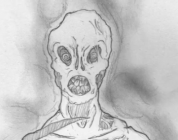Dead Kansas was originally conceived as a short film that soon expanded into a five-part web series. Today’s piece is not a review, but a call to arms for all up-and-coming filmmakers to make that art–your art–, despite complications, lack of funds, and self-doubt. Dead Kansas, serves as a case study to that tenacity to create as a movie that is as low-budget as you can get, yet exudes passion, fortitude, and creativity.
Like I alluded earlier, Dead Kansas evolved from a short film, to a five-part web series, and finally in its latest rendition as a full film in five acts (the five episodes put together). That being said, Aaron K. Carter’s film should be an inspiration to filmmakers; simply take a look at the ultra-low-budget production and you can tell there was passion behind the project, otherwise why would any independent filmmaker put themselves through the grueling nature of filmmaking? No physical nor monetary obstacles should hold an artist in the grips of failure, in fact, those same limitations and how they are handled are what differentiates those who put themselves out there and those who wallow in a state of uncreative stasis with maybes and what-ifs.
Apart from the physical obstacles that arise in filmmaking there are also the pangs of crippling self-doubt, a dirk in the heart of passion that usually leads to indefinite procrastination. The mind is an incredibly complex well of creativity, that is also a private hell of doubt, and even worse regret. Act on that doubt– action is key. The first step is to take that first step.
In the bare minimum there will exist a creation that germinated in the mind and exists as a tangible, viewable perspective and sensibility of the world– why else make films? This is something that I can personally relate to, as a person that suffers from self-doubt on a daily basis. I think that the best term that describes this is an archaic phrase that I pulled from Joyce’s “Ulysses”: Agenbite of Inwit– which means “remorse of conscience.” Don’t let your conscience cannibalize your ability and physicality to create. The mind is just one component, and while great ideas are born of the mind, they are crafted and manifest in the physical world.
I made two one minute short films in film school, that I am not too proud of artistically, but nonetheless exist despite internal doubt and hopelessness. However, I know how much work I physically and mentally put into those projects– they weren’t bad because of a lack of trying, far from that, they are lessons on how to improve and a realization that passion trumps doubt on any day.
But what’s with all this preachy and didactic quais-essayistic piece? It’s all because of a little movie I had a chance to watch that inspired this write-up. Now that I have all that preceded out of the way, let’s talk about what Dead Kansas actually is.
Dead Kansas is about a post-apocalyptic zombie flick set in Kansas in a world overrun by “Rottens” (a creative name for zombies). The movie is full of references to the film “The Wizard of Oz,” however, Dead Kansas concerns itself with a farmer, Glenn (Aaron Guerrero) and his beautiful daughter Emma (Alexandria Lightford and Erin Miracle). Their problems don’t end with the Rottens, since the fall of humanity the birth rate has dropped, and being one of the few remaining attractive women, she has attracted the lusty eyes of the insidious gang. Glenn, the pious man he is, attempts to calmly deter the group. Things take a turn for the worse when Glenn kills Jebediah’s brother. Jebediah–the leader of the gang– played by Michael Camp— seeks revenge by attempting to kidnap Emma after an impending tornado. Along the way she meets allegorical friends that allude to characters from “The Wizard of Oz” (Rusty, Skinny, and Leo played by Kevin C. Beardsley, Joe McQueen, and Romeo de Lan, respectively) who help her in stopping the nefarious Jeb, as she also seeks a doctor for her father.
The achievement of Dead Kansas is that it takes everything at its disposal and makes the San Fernando Valley (the Greater Los Angeles area) look like Kansas– two differing locations that have very different geographies. The best filmmakers make due with the least amount of resources, and even better ones, can “fake it” and make you believe you are where they say you are.
Furthermore, the filmmakers appear to be unfazed by production complications, finding solutions for arising problems. Carter and company exhibit a tenacity to plow through their project, despite Alexandria Lightford’s (who plays Emma) pregnancy in the middle of production. This didn’t hinder the filmmakers one bit, because of scheduling complications, rather than placing the remainder of the project on hiatus, Lightford was simply recast with Erin Miracle— the show must go on! It takes utter ingenuity to problem solve amidst financial complications or obstacles and Dead Kansas proves just that. The Rottens in the film, a lot of the times, are never really shown (except for a final moment), but are instead implied through a first person point-of-view photographed in black and white.
These small facets that are interspersed throughout the story are not merely gimmicks– which I’m sure would have made production much easier– but are essential to the story that Aaron K. Carter and Nicholas A. DeNicola (Co-writer) are trying to tell. They wanted a post-apocalyptic world with zombies and they made it happen in their own limited way. The lesson here is that there are no constraints or limitations on art or film– if you want zombies, you find a way damn it!
Dead Kansas won Best Zombie Film at San Diego’s FANtastic Horror Film Festival in 2014 and was also nominated for Best Supporting Actor Joe McQueen and Best Line (“Live in Hell long enough, everyone turns into a demon”).
You can rent the movie on Amazon Video, which is available now.

